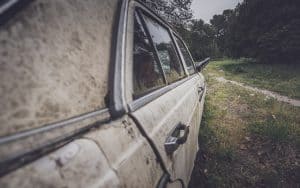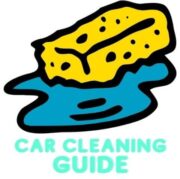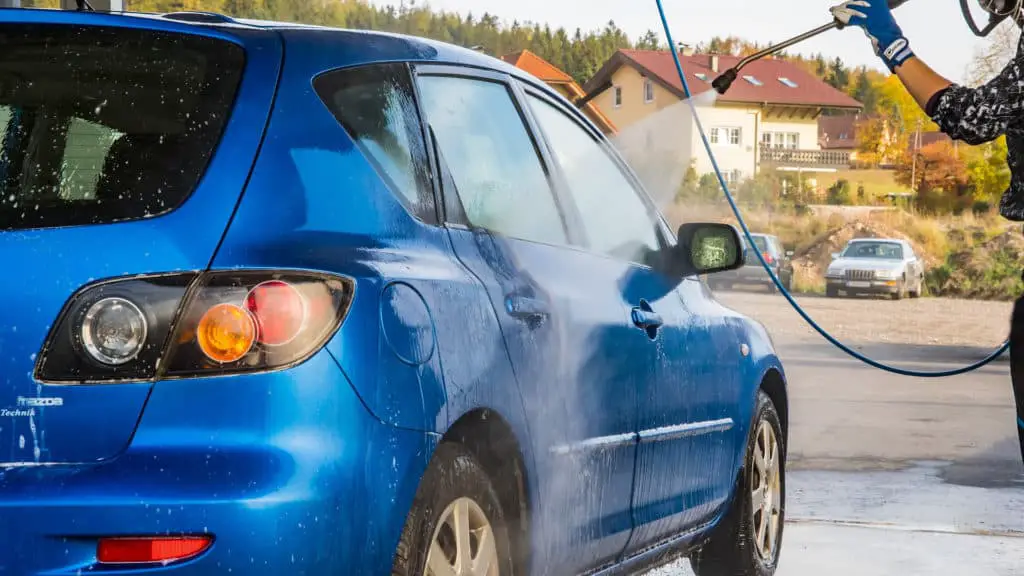- What Is The Two Bucket Method To Wash Car Properly - July 2, 2021
- 5 Best Car Seat For Grandparents That Impress Your In Laws - May 18, 2021
- 5 Best Rooftop Cargo Box For Audi Q5 [Review & Buying Guide] - May 11, 2021
Last Updated on July 5, 2023 by Chase Manhattan
Washing your car or truck by hand is very rewarding but takes time and physical effort.
You may not have enough time during your day to cover every inch of your dirty car by hand, but this does not mean you can’t wash your car! Although you could easily go to an automatic car wash, it is not highly recommended.
Rather, you should consider a pressure washer instead of using a garden hose. There are many different products and methods that can be used to pressure wash a car. Some essentials like a good car wash soap with strong cleaning power, any type of pressure washer with consistent water flow, and 40-degree nozzle tips if you plan on washing your undercarriage. If you’ve been reading for any period of time, you’ll know I’m an advocate for homemade car wash soaps and household soaps that won’t strip wax, but you’ll need a foam cannon specific soap should you decide to use one with your pressure washer.
This comprehensive guide covers everything you need to know to pressure wash your car.
Before starting, you may wonder if using a pressure washer on a car is good or bad. There are many advantages to a pressure washer for your car, but there are also some important disadvantages to consider.
Quick Navigation
Pressure Wash A Car: Good or Bad?
There are many different opinions about washing a car with a pressure washer. You may ask yourself, “Is pressure washing cars good or bad?” The answer is neither, it all depends on the pressure washer and the user.
There are pros and cons when you use a pressure washer on a car, so you’ll need to consider all of them before deciding to continue.
Here are four basic reasons that pressure washers can be good or bad for washing a car.
Quick and Easy
It is much quicker and easier than hand washing a car, which requires more materials and takes longer to cover all of the car’s exterior.
When washing a car with a pressure washer, you only need your high pressure washer and car wash soap.
Pressure washers also have the added benefit of extra attachments, such as foam cannons or a 40-degree nozzle. This will make it even easier to remove dirt from your car. Those who use foam tend to use less pressure so that all the soap doesn’t get blown away by the pressurized water.
A car wash with high-pressure garden hoses also makes washing much easier. They are designed specifically to handle the pressure level that comes from pressure washers.
It reduces physical effort since you won’t need to bend over to hand-wash the entire car. Additionally, larger vehicles are much easier to clean with high-pressure because they have spots that are hard to reach like wheel arches and larger undercarriages.
Helps Minimize Scratches
Scratches are very possible when washing a car by hand. Dirt, grit, and other loose debris can stick to a car’s surface during a wash, and then can stick to a wash mitt and cause scratches in the car’s paint. There are methods to help prevent this, like waxing your car, but it is still a common problem. Anytime you’re scrubbing stubborn dirt, make sure there is plenty of soapy water for lubrication. If you’d like to prevent this dirt build up in the first place, I recommend you look into the benefits of waxing your car as this is a primary benefit along with sealing the surface which will keep other debris like pollen off your car.
[Six Common Causes of Car Scratches]
High-pressure car cleaning avoids direct contact with the paint, therefore reducing the potential for scratches. Loose debris is instantly washed away when hit with water rather than sticking to a wash mitt. This is why it’s important to know how to wash a car with a pressure washer, and also how much pressure you’re using when doing so.
May Leave Some Dirt Behind
It may not clean all the dirt off your vehicle if you have less pressure than other pressure washers. Lower pressure means there is a lower PSI – pounds per square inch; conversely, more pressure means a higher PSI. Both gas pressure washers, and electric pressure washers, will have a pounds per square inch rating on the box when new.
Although touchless washing has benefits, some dirt simply won’t come off the paint job without direct contact, and the appropriate psi. This is why it’s good to use a pressure washer with more pressure and hot water when you can. As necessary, you can break out the handy dandy scrub brush or soft cloth. Otherwise, you can sometimes accommodate for lower pressure with an aggressive spray pattern. This is why it’s important to know how to pressure wash a car. A pressure washer requires thought, and some previous knowledge.
It can be disappointing to see spots with leftover loose dirt after you’ve pressure washed the car.
When the car is wet, it can be more difficult to find spots that are still dirty. Therefore, you can easily leave dirt behind, which you won’t notice until the car is dry.
You can attempt to prevent this by keeping track of which panels or sides of the car you have cleaned.
Although most dirt is rinsed away, you may find a few spots with a thin layer of leftover dirt.
This can be fixed by following up with an Instant Detailing Spray to take care of small dirty spots.
[Drying A Car With A Leaf Blower]
Can Damage the Paint

Although scratches are prevented by avoiding direct contact, it is not impossible to scratch the paint job while washing cars.
Using a pressure washer with large amounts of loose dirt can be damaging if you aren’t careful.
If pressurized water is immediately used on the dirty surface, all the dirt can be pushed against the paint causing scratches.
This can be avoided by washing stubborn dirt first with a light hot water stream with lower pressure or a normal garden hose with the appropriate PSI. Make sure you have the right nozzle to spray water when doing so.
Additionally, washing a car on a surface with stones or heavy dirt, such as a gravel driveway or grass, can cause damage if particles are knocked into the air when the high-pressure hose is aimed at the ground. So be careful where you spray water.
If paint chips or flakes are present on your vehicle, they can be made larger, causing more damage. A high-pressure water stream can travel under the chips and begin stripping paint from the car’s surface. Make sure you know your pressure level beforehand.
This is especially common with older vehicles. Therefore, you should be extremely careful to avoid damaging them when you start pressure washing a car. Again, it’s important to know how to pressure wash your car.
Use caution when getting the hose within 6 inches of your car’s exterior. Sometimes you can’t be sure how much pressure you’re using. Do not spray door and window seals at close range. If you damage the window seals you’ll be in for an unfortunate surprise next time it rains.
[Removing Mold From Car Window Seals]
Using Car Soap with a Pressure Washer
There are two ways to integrate soap into the pressure washer. While the first method is most effective, the second can be easier and uses less materials.
Foam Cannon
The most effective (and satisfying) way of washing a car is using a foam gun to apply detergent. A foam cannon sprays a thick layer of soap onto the car’s surface to break up and remove dirt.
This helps remove more dirt without having to touch the entire car with a wash mitt. Most foam cannons are very similar (even the more expensive ones) and will work fine, but it is important to buy one with solid metal parts instead of plastic.
I recommend the Selkie Foam Gun Kit because it is cost-effective, well-made, and gets the job done.
You can use any normal car wash soap with your foam cannon. I’ve had great results using Meguiar’s Gold Class car wash soap with the MATCC foam cannon.
Detergent Tank
The second way to integrate soap into the pressure washer is using the detergent tank on the machine.
Although it will not produce as much soap as the foam gun, it can be easier to use and requires less materials than washing a car by hand.
If using the detergent tank to pressure wash a car, you can use a soap designed for car washing with pressure washers or a normal car wash soap.
How to Pressure Wash a Car
- Lightly rinse heavy dirt off the vehicle with water from top to bottom. Use low pressure and spray more than 3 feet away from the vehicle.
- Begin spraying detergent onto the vehicle using either the detergent tank in your pressure washer or a foam cannon.
- Start spraying detergent into the wheel wells and under the vehicle if desired.
- If using a foam gun, let the soap sit on the car for a minute before rinsing. Avoid allowing the soap to dry, as this could leave a residue on the car. Wipe with a wash mitt as necessary.
- Thoroughly rinse detergent from the vehicle in a top to bottom spray pattern, keeping the pressure washer hose more than 1 foot from the surface of the car. Re apply detergent if necessary.
- If spraying too close, you could strip paint and cause other damage.
- The car will need rinsed more thoroughly than when hand-washed because soap reaches more cracks and crevices when using a pressure washer.
Tips for Using a Pressure Washer for Car Detailing
When using a pressure washer for car detailing, there are a few tips you should keep in mind. First, always read the instructions before using the pressure washer to make sure you’re using it safely. Second, use the lowest pressure setting possible to avoid damaging your car’s finish. Third, always use a pressure washer with a foam cannon to avoid scratching your car’s paint. Finally, be sure to use a car soap designed for use with a pressure washer to ensure the best results.
Is High-Pressure Car Cleaning Right for You?
A high-pressure car wash could be the perfect option for you for several reasons:
- If you don’t have time to wash by hand, it is a much quicker process. You don’t even need any materials, as self-serve car wash stations are common and easy to find.
- To minimize scratches, especially on black cars. Black cars are notorious for swirl marks and scratches caused by hand-washing, so high-pressure car cleaning could be the best option to prevent this damage.
- To easily clean larger vehicles. Larger vehicles can be difficult and time-consuming to wash by hand. High pressure cleaning makes this easier and more effective.
- To quickly clean vehicles that don’t need a perfect wash. Not all vehicles need a spotless clean, such as work trucks.
Know that not everybody will know how to pressure was a car. Washing a car with a pressure washer is typically left to those uninitiated, and those in the detailing industry.
How Many PSI To Wash Car?
When washing your car with a pressure washer, the best range will be between 1200 to 1900 psi. Most pressure washers can be set to this pressure.
Make sure to use the right nozzle, with a nozzle tip greater than 25 degrees when cleaning your car. And keep the tip of the pressure washer at a minimum of 6 inches from your vehicle.
Wrap Up
Regardless if which pressure washer you choose, an electric pressure washer and gas powered machines both have improved greatly. Regardless of your needs, you will be able to wash your car quickly, safely, and thoroughly without damaging your car’s paint.
Remember these important tips and guidelines when you pressure wash a car:
- Use a safe PSI for washing cars (2,000 PSI or less)
- Use a nozzle tip greater than 25 degrees
- A foam cannon will break up dirt more than using your detergent tank
- Use caution when pressure washing closer than 6 inches
- Use caution when pressure washing older cars with rough, fragile paint jobs
- Keep track of the parts of the car that you haven’t washed to avoid missing spots





